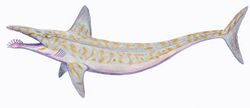Biology:Parahelicoprion
| Parahelicoprion | |
|---|---|

| |
| Scientific classification | |
| Domain: | Eukaryota |
| Kingdom: | Animalia |
| Phylum: | Chordata |
| Class: | Chondrichthyes |
| Subclass: | Holocephali |
| Order: | †Eugeneodontida |
| Family: | †Helicoprionidae |
| Genus: | †Parahelicoprion Karpinsky, 1924 |
| Type species | |
| Helicoprion clerci Karpinsky, 1916
| |
| Species | |
| |
Parahelicoprion is an extinct genus of shark-like eugeneodontid holocephalids from the Permian of the Ural Mountains (Russia ) and Copacabana Formation, Bolivia.[1] The genus name, from "nearly coiled saw" in Greek, directly refers to Helicoprion, a related holocephalid that shares similar traits to it, including the helical whorl of teeth.
The holotype of Parahelicoprion is based on a poorly preserved material,[1] so its size estimates along with those of some other large eugeneodonts are highly subjective due to their fragmentary fossil remains that cannot provide an empirical basis.[2] While Karpinsky separated the type species from the genus Helicoprion,[3] it has been recently suggested that this genus does represent a junior synonym of Helicoprion.[4]
Description
One of the primary qualities that separate Parahelicoprion from Helicoprion is the shape, thickness, and angle of the tooth whorl. Its teeth protrude outwards not like a tightly coiled saw, but instead a curved arrangement of cutting blades indicating it relied less on crushing slow-moving invertebrates and catching cephalopods, or other small mollusk prey, but inflicting traumatic damage against more durable, faster prey.[5] Their teeth grew at a much slower pace than those of other whorl-tooth sharks, resulting in a depreciated spiral, growing only half of the teeth a Helicoprion would grow in its lifetime. The tooth spiral also was able to indicate the age of the eugeneodontidans in question.[6]
Paleobiology
Parahelicoprion is thought to have been a nektonic carnivore that probably preyed upon a variety of different species, using its blade-like teeth to cut at exposed flesh like a hatchet or wedge.[7]
References
- ↑ 1.0 1.1 Merino-Rodo, Dagmar (1986). "Chondrichthyan and actinopterygian remains from theLower Permian Copacabana Formation of Bolivia". Geobios 19 (4): 479–493. doi:10.1016/S0016-6995(86)80005-5. Bibcode: 1986Geobi..19..479M.
- ↑ Maisey, John G.; Bronson, Allison W.; Williams, Robert R.; McKinzie, Mark (2017-05-04). "A Pennsylvanian 'supershark' from Texas" (in en). Journal of Vertebrate Paleontology 37 (3): e1325369. doi:10.1080/02724634.2017.1325369. ISSN 0272-4634. Bibcode: 2017JVPal..37E5369M. https://www.tandfonline.com/doi/full/10.1080/02724634.2017.1325369.
- ↑ Karpinsky, A.P. (1924). "Helicoprion (Parahelicoprion n.g.) clerci". Zapiski Ural'skogo Obshchestva Estestvoispytatelei 34: 1–10.
- ↑ Naugolnykh, S.V. (2018). "Artinskian (Early Permian) Sea Basin and Its Biota (Krasnoufimsk, Cis-Urals)". Stratigraphy and Geological Correlation 26 (7): 734–754. doi:10.1134/S0869593818070080. Bibcode: 2018SGC....26..734N.
- ↑ http://dinonews.net/forum/paleoactus.php?msg=168926 Parahelicoprion and Agassizodontidea
- ↑ Brad Matsen and Ray Troll (October 25, 2012). "Planet Ocean: A Story of Life, the Sea, and Dancing to the Fossil Record".
- ↑ "Fossilworks: Parahelicoprion". http://www.fossilworks.org/cgi-bin/bridge.pl?a=taxonInfo&taxon_no=34463.
Wikidata ☰ Q7134758 entry
 |

